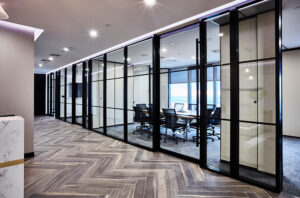Being a commercial floor sander is a discipline where craftsmanship meets precision engineering. To the untrained eye, it may seem a straightforward task: a matter of running a powerful machine across a wooden surface until it looks clean and new. Yet, for the professional, the process is a dance of nuanced technique, deep knowledge, and an understanding of many variables—wood grain, abrasives, finish types, and client expectations. In this guide, we will unveil the trade secrets of seasoned commercial floor sanders—those learned over years of dust, sweat, and the relentless pursuit of the perfect finish.
A Commercial Floor Sander – Preparation is Everything
- Inspect the Floor: Before setting up a single machine, a professional surveys the site. Is the wood cupped, crowned, or uneven? Are there loose boards or protruding nails? Every imperfection must be noted.
- Moisture Matters: Measure the humidity of both the floor and the ambient air. Wood is a living material—too damp and it will warp after sanding. Too dry, and it might crack or splinter.
- Clear the Room: Remove all furniture, rugs, and even wall hangings if possible. Fine dust finds its way into every nook and cranny, and even a small obstacle can ruin a perfect pass.
- Seal Off Areas: Use plastic sheeting and painter’s tape to keep dust contained. A clean working environment is essential for a flawless finish.
Choosing the Right Tools
- Drum vs. Belt Sanders: Drum sanders are aggressive; they remove material quickly but require a steady hand and experience. Belt sanders are more forgiving and ideal for less damaged floors.
- Edge Sanders: No matter how skilled the operator, large sanders can’t reach into corners or along baseboards. That’s where a good edge sander comes in—choose one with variable speed and a dust collection system.
- Buffers and Polishers: The final step for a glass-like surface. Buffers blend out minor imperfections and prepare the wood for finishing coats.
- Abrasives: The choice of sandpaper is a trade secret in itself. Start with a coarser grit (often 36 or 40) to remove old finish and level the floor, progressing up to 80-120 grit for a smooth, ready-to-finish surface.
 Techniques Only the Pros Know
Techniques Only the Pros Know
- The Zigzag Method: Avoid long, straight passes on the initial sand. Instead, move the sander in a slow zigzag, overlapping each pass. This prevents “dish-outs”—low spots that catch the light and betray inexperience.
- Feathering Edges: Where two passes meet, gently lift the drum or lighten pressure to blend the overlap. A visible seam is a hallmark of the amateur.
- Dust Management: True professionals never let dust accumulate. High-grade vacuums attached to machines, frequent filter changes, and a second pass with a microfiber cloth are essential steps.
- Spot Repairs: Fill small gaps with a custom mix of sawdust and wood filler, coloured to match the floor. For deeper gouges, splice in matching wood, glued and clamped securely, then sand to blend.
Understanding the Wood
- Grain Direction: Always sand with the grain on the final pass. Across the grain can help level uneven boards initially but will leave scratches if not properly removed with finer grits.
- Species Sensitivity: Oak is forgiving, but maple, cherry, and walnut are considerably less so. Exotic woods may gum up sandpaper or react unpredictably to certain finishes.
- Veneers vs. Solid Wood: Commercial spaces often use engineered (veneered) floors. These require a delicate touch—sand too deep and you’ll expose the plywood beneath.
Secrets of the Perfect Finish
- Cleaning Between Coats: After sanding, vacuum thoroughly, then wipe the floor with a damp cloth or tack rag to pick up fine dust. Repeat between each coat of finish.
- Conditioning the Wood: Some woods benefit from a pre-stain conditioner to ensure even absorption and prevent blotching.
- Application Techniques: Use a lambswool applicator or a high-quality brush. Apply finish in thin, even coats—never try to rush with thick applications, as they will bubble or orange-peel.
- Buffing Between Coats: Lightly buffing with a fine abrasive pad between coats creates microscopic scratches that help the next layer adhere and smooths out imperfections.
- Humidity Control: Apply finishes in conditions with controlled humidity and temperature. Fluctuations can cause cloudy finishes or uneven drying.
Commercial-Grade Challenges
- Traffic Patterns: In commercial spaces, floors take a beating. Pay special attention to high-traffic areas—sometimes they require extra passes or even a different finish with greater durability.
- Fast Turnarounds: Deadlines are tight. Use fast-curing finishes (like water-based polyurethanes) when necessary, but always balance speed against the desired aesthetics and longevity.
- Client Communication: Set expectations early. Explain what can and cannot be fixed, the time required, and care for the finished floor. An informed client is a satisfied client.
 Advanced Tips and Tricks
Advanced Tips and Tricks
- Sample Areas: On tricky jobs, sand and finish a small, inconspicuous area first to confirm compatibility and appearance.
- Lighting: Use raking light—shine a torch or work light low and parallel to the floor to reveal imperfections invisible under ambient light.
- Layered Finishes: For an ultra-durable floor, consider layering different finishes. For example, begin with a sealer, add a coat of oil-based polyurethane for depth, and top with a water-based finish for resilience.
- Odour Management: Use low-VOC or odourless finishes in sensitive environments—restaurants, hospitals, businesses open to the public.
- Maintain Your Tools: Dull sandpaper, clogged filters, and poorly maintained machines are the enemy of quality work. Clean, inspect, and replace components regularly.
Common Mistakes to Avoid
- Skipping Grits: Never skip from coarse to fine sandpaper. Each grit removes the scratches of the previous one—missing a step leaves visible marks.
- Ignoring Corners: Failing to properly blend edges and corners makes new floors look patchy and unfinished.
- Underestimating Dust: Even a fine layer of dust can ruin a finish. Be obsessive about cleaning at every stage.
- Rushing the Job: Haste leads to missed imperfections, uneven coatings, and callbacks. Take time for each step—preparation, sanding, cleaning, and finishing.
The Professional Mindset
A commercial floor sander is more than a technician; they are an artisan and a steward of the space. Pride in workmanship, relentless attention to detail, and a willingness to keep learning define the experts in this trade. They keep up with new materials, finishes, and tools, and share wisdom with up-and-coming sanders—ensuring each project reflects the best of the craft.
Behind every beautifully restored wooden floor in a commercial space lies a host of trade secrets: thoughtful preparation, mastery of machinery, knowledge of wood’s quirks, and an artist’s eye for detail. By respecting these secrets and honing their skills, commercial floor sanders transform worn, battered surfaces into gleaming, resilient works of art—making their mark, one floor at a time. Looking for a commercial floor sanding company? Call today on 0800 852 7177.

 Advanced Tips and Tricks
Advanced Tips and Tricks
Leave A Comment